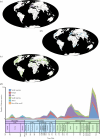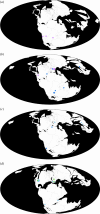The spatiotemporal distribution of Mesozoic dinosaur diversity
- PMID: 39660360
- PMCID: PMC11632528
- DOI: 10.1098/rsbl.2024.0443
The spatiotemporal distribution of Mesozoic dinosaur diversity
Abstract
Much of our view on Mesozoic dinosaur diversity is obscured by biases in the fossil record. In particular, spatiotemporal sampling heterogeneity affects identification of the timing and geographical location of radiations, the recognition of the latitudinal diversity gradient, as well as interpretation of purported extinctions, faunal turnovers and their drivers, including the Early Jurassic Jenkyns Event and across the Jurassic/Cretaceous boundary. The current distribution of sampling means it is impossible to robustly determine whether these 'events' were globally synchronous and geologically instantaneous or spatiotemporally staggered. Accounting for sampling heterogeneity is also paramount to reconciling notable differences in results based on sampling-standardized dinosaur species richness versus reconstructions of diversification rates, particularly with regards to the lead-up to the Cretaceous/Paleogene mass extinction. Incorporation of a greater proportion of stratigraphically well-resolved dinosaurs into analyses is also imperative and must include the substantial Mesozoic radiation of birds. Given the relative rarity of temporally successive, well-sampled spatial windows, it remains possible that dinosaur species richness and diversification rate showed little change after the clade's initial radiation until the Cretaceous/Paleogene boundary. However, better understanding of underlying sampling, combined with a holistic approach to reconstructing dinosaur diversity and diversification, is an important step in testing this hypothesis.
Keywords: Dinosauria; Mesozoic; common cause hypothesis; diversity; extinction; latitudinal diversity gradient.
Conflict of interest statement
I declare I have no competing interests.
Figures



Similar articles
-
How many dinosaur species were there? Fossil bias and true richness estimated using a Poisson sampling model.Philos Trans R Soc Lond B Biol Sci. 2016 Apr 5;371(1691):20150219. doi: 10.1098/rstb.2015.0219. Philos Trans R Soc Lond B Biol Sci. 2016. PMID: 26977060 Free PMC article.
-
Dinosaur morphological diversity and the end-Cretaceous extinction.Nat Commun. 2012 May 1;3:804. doi: 10.1038/ncomms1815. Nat Commun. 2012. PMID: 22549833
-
Biotic and environmental dynamics through the Late Jurassic-Early Cretaceous transition: evidence for protracted faunal and ecological turnover.Biol Rev Camb Philos Soc. 2017 May;92(2):776-814. doi: 10.1111/brv.12255. Epub 2016 Feb 17. Biol Rev Camb Philos Soc. 2017. PMID: 26888552 Free PMC article.
-
Testing co-evolutionary hypotheses over geological timescales: interactions between Mesozoic non-avian dinosaurs and cycads.Biol Rev Camb Philos Soc. 2009 Feb;84(1):73-89. doi: 10.1111/j.1469-185X.2008.00065.x. Epub 2008 Dec 19. Biol Rev Camb Philos Soc. 2009. PMID: 19133960 Review.
-
The macroecology of Mesozoic dinosaurs.Biol Lett. 2024 Nov;20(11):20240392. doi: 10.1098/rsbl.2024.0392. Epub 2024 Nov 13. Biol Lett. 2024. PMID: 39535111 Free PMC article. Review.
Cited by
-
New frontiers in dinosaur exploration.Biol Lett. 2025 Apr;21(4):20250045. doi: 10.1098/rsbl.2025.0045. Epub 2025 Apr 30. Biol Lett. 2025. PMID: 40304201 Free PMC article. Review.
-
Dinosaur science.Biol Lett. 2025 Jul;21(7):20250297. doi: 10.1098/rsbl.2025.0297. Epub 2025 Jul 2. Biol Lett. 2025. PMID: 40592468 Free PMC article. No abstract available.
References
-
- Brusatte SL, Nesbitt SJ, Irmis RB, Butler RJ, Benton MJ, Norell MA. 2010. The origin and early radiation of dinosaurs. Earth Sci. Rev. 101, 68–100. (10.1016/j.earscirev.2010.04.001) - DOI
-
- Langer MC, Ramezani J, Da Rosa ÁAS. 2018. U-Pb age constraints on dinosaur rise from south Brazil. Gondwana Res. 57, 133–140. (10.1016/j.gr.2018.01.005) - DOI
-
- Benson RBJ. 2018. Dinosaur macroevolution and macroecology. Annu. Rev. Ecol. Evol. Syst. 49, 379–408. (10.1146/annurev-ecolsys-110617-062231) - DOI
Publication types
MeSH terms
Grants and funding
LinkOut - more resources
Full Text Sources

